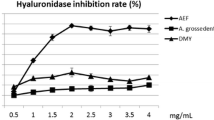Abstract
Anti-inflammatory effects of eicosapentaenoic (EPA) and docosahexaenoic acids (DHA) were examined on three models of skin inflammation induced in mice by topical application of an arachidonic acid (AA) solution, ultraviolet-B (UVB) irradiation, and contact sensitization with dinitrofluorobenzen. Ear oedema reactions induced by AA and UVB irradiation were significantly suppressed in mice fed a daily dose of 300 mg/kg EPA for 2 weeks. The contact hypersensitivity reaction was not impaired by EPA. None of the skin reactions was significantly inhibited in mice fed DHA or safflower oil. The results suggest that EPA, but not DHA, has anti-inflammatory effects on AA- and UVB-induced acute inflammation reactions.
Similar content being viewed by others
References
Bittiner S, Tucker WFG, Cartwright I, Bleehen SS (1988) A double-blind, randomised, placebo-controlled trial of fish oil in psoriasis. Lancet I: 378–380
Black AK, Fincham N, Greaves MW, Hensby CN (1980) Time course changes of arachidonic acid and prostaglandins D2, E2, F2α in human skin following ultraviolet-B irradiation. Br J Clin Pharmacol 10: 453–457
Corey EJ, Shih C, Cashman JR (1983) Docosahexaenoic acid is a strong inhibitor of prostaglandin but not leukotriene biosynthesis. Proc Natl Acad Sci USA 80: 3581–3584
Danno K, Horio T (1987) Sunburn cell: factors in its formation. Photochem Photobiol 45: 683–690
Danno K, Toda K, Ikai K, Horio T, Imamura S (1990) Ultraviolet radiation suppresses mouse-ear edema induced by topical application of arachidonic acid. Arch Dermatol Res 282: 42–46
Danno K, Imamura S, Fujita M, Ohno S, Miyachi Y (1991) Treatment of psoriasis vulgaris with eicosapentaenoic acid (EPA). Acta Dermatol (Kyoto) 86: 471–476
Kelley VE, Ferretti A, Izui S, Strom TB (1985) A fish oil diet rich in eicosapentaenoic acid reduces cyclooxygenase metabolites, and suppresses lupus in MRL-lpr mice. J Immunol 134: 1914–1919
Kojima T, Terano T, Tanabe E, Okamoto S, Tamura Y, Yoshida S (1991) Long-term administration of highly-purified eicosapentaenoic acid provides improvement of psoriasis. Dermatologica 182: 225–230
Kragballe K, Fogh K (1989) A low-fat diet supplemented with dietary fish oil (Max-EPA) results in improvement of psoriasis and in formation of leukotriene B5. Acta Derm Venereol (Stockh) 69: 23–28
Kragballe K, Voorhees JJ, Goetzl EJ (1985) Leukotriene B5 derived from eicosapentaenoic acid does not stimulate DNA synthesis of cultured human keratinocytes, but inhibits the stimulation induced by leukotriene B4 (abstract). J Invest Dermatol 84: 349
Lee TH, Mencia-Huerta J-M, Shih C, Corey EJ, Lewis RA, Austen KF (1984) Effects of exogenous-arachidonic, eicosapentaenoic, and docosahexaenoic acids on the generation of 5-lipoxygenase pathway products by ionophore-activated human neutrophils. J Clin Invest 74: 1922–1933
Lee TH, Hoover RL, Williams JD, Sperling RI, Ravalese III J, Spur BW, Robinson DR, Corey EJ, Lewis RA, Austen KF (1985) Effect of dietary enrichment with eicosapentaenoic and docosahexaenoic acids on in vitro neutrophil and monocyte leukotriene generation and neutrophil function. N Engl J Med 312: 1217–1224
Maurice PDL, Allen BR, Barkley A, Cockbill SR, Stammers J, Bather PC (1987) The effects of dietary supplementation with fish oil in patients with psoriasis. Br J Dermatol 117: 599–606
Miller CC, Yamaguchi RY, Ziboh VA (1989) Guinea-pig epidermis generates putative anti-inflammatory metabolites from fish oil polyunsaturated fatty acids. Lipids 24: 998–1003
Opas EE, Bonney RJ, Humes JL (1985) Prostaglandin and leukotriene synthesis in mouse ears inflamed by arachidonic acid. J Invest Dermatol 84: 253–256
Ruzicka T, Walter JF, Printz MP (1983) Changes in arachidonic acid metabolism in UV-irradiated hairless mouse skin. J Invest Dermatol 81: 300–303
Santoli D, Zurier RB (1989) Prostaglandin E precursor fatty acids inhibit human IL-2 production by a prostaglandin E-independent mechanism. J Immunol 143: 1303–1309
Schaffer HKL (1989) Essential fatty acids and eicosanoids in cutaneous inflammation. Int J Dermatol 28: 281–290
Terano T, Salmon JA, Moncada S (1984) Effect of orally-administered eicosapentaenoic acid (EPA) on the formation of leukotriene B4 and leukotriene B5 by rat leukocytes. Biochem Pharmacol 33: 3071–3076
Terano T, Salmon JA, Moncada S (1984) Biosynthesis and biological activity of leukotriene B5. Prostaglandins 27: 217–232
Terano T, Salmon JA, Higgs GA, Moncada S (1986) Eicosapentaenoic acid as a modulator of inflammation. Effect on prostaglandin and leukotriene synthesis. Biochem Pharmacol 35: 779–785
Terano T, Kojima T, Seya A, Tanabe E, Hirai A, Makuta H, Ozawa A, Fujita T, Tamura Y, Okamoto S, Yoshida S (1989) The effect of highly-purified eicosapentaenoic acid in patients with psoriasis. In: Samuelsson B, Wong PY-K, Sun FF (eds) Advances in prostaglandin, thromboxane, and leukotriene research, vol 19. Raven Press, New York, pp 610–613
Yamashita N, Maruyama M, Yamazaki K, Hamazaki T, Yano S (1991) Effect of eicosapentaenoic and docosahexaenoic acid on natural killer cell activity in human peripheral blood lymphocytes. Clin Immunol Immunopathol 59: 335–345
Young JM, Spires DA, Bedord CJ, Wagner B, Ballaron SJ, De Young LM (1984) The mouse ear inflammatory response to topical arachidonic acid. J Invest Dermatol 82: 367–371
Ziboh VA, Cohen KA, Ellis CN, Miller C, Hamilton TA, Kragballe K, Hydrick CR, Voorhees JJ (1986) Effects of dietary supplementation of fish oil on neutrophil and epidermal fatty acids. Arch Dermatol 122: 1277–1282
Author information
Authors and Affiliations
Rights and permissions
About this article
Cite this article
Danno, K., Ikai, K. & Imamura, S. Anti-inflammatory effects of eicosapentaenoic acid on experimental skin inflammation models. Arch Dermatol Res 285, 432–435 (1993). https://doi.org/10.1007/BF00372139
Received:
Issue Date:
DOI: https://doi.org/10.1007/BF00372139




